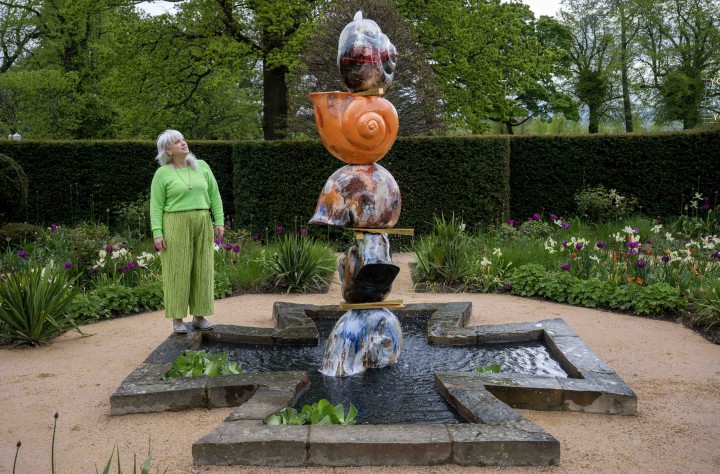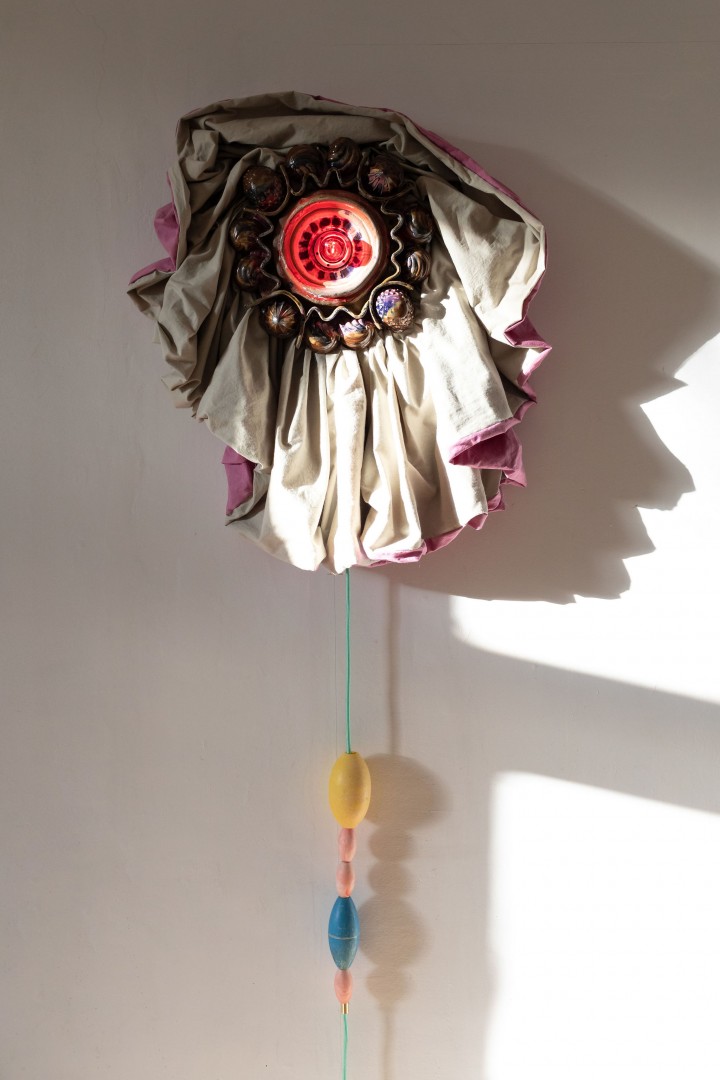Scottish Art News
Latest news
Magazine
News & Press
Publications
Artist Interview: Laura Aldridge
By Neil Cooper, 30.05.2024

Homeliness is where the heart is in Lawnmower, Laura Aldridge’s domestically inclined new commission and accompanying exhibition that has just opened as part of Jupiter Artland’s 2024 summer season. You can see it in the Edinburgh sculpture park’s Steadings Gallery, where hand crafted love seats are given the names ‘You & Me I’ (2024), ‘You & Me II’ (2024), ‘You & Me III’ (2024). These are watched over by a series of wall mounted globe lights in coloured skirts that – with names like ‘Housework (Ultra Vivid Scene)’ (2024), and ‘We too form a multitude (my brain is everywhere)’ (2024) - give the lights the air of blank faced disembodied doll heads.
 Jupiter Artland Laura Aldridge Installation, Image courtesy of Jupiter Artland
Jupiter Artland Laura Aldridge Installation, Image courtesy of Jupiter Artland
The seats themselves are decorated with ornaments that offer up appealingly tactile armrests that allow the sitter to view three screens beaming out seventeen-minute video installation, ‘Go Wo Mango!’ (2024). This was made by Aldridge in collaboration with fellow artists Juliana Capes, Morwenna Kearsley and Sarah McFadyen, with a soundtrack formed from a set of newly composed songs given voice by Capes.
Beyond the Steadings is Aldridge’s permanent commission for Jupiter Artland, ‘A Cosmic Reset’ (2024). Located in the garden beside the Ballroom gallery, this working fountain is made of a tower of wildly painted giant ceramic shells. The effect of all this is both decorative and functional in a display set against a riot of bright colours that adorn the Steadings’ floor and walls in a way that makes it feel like a wonkily eccentric living room.
Aldridge is used to working in similarly inclined domestic settings by way of Sculpture House, the Paisley based centre the Guildford born artist co-founded with fellow sculptors Nick Evans and James Rigler. Having stumbled on the then derelict local authority owned former social work building in Paisley’s Ferguslie Park area, the trio set about transforming it into a studio and workshop space.
While not quite as grand as Jupiter Artland, Sculpture House is as bright as the ideas that radiate from Aldridge in Lawnmower, the starting point of which came from a collaboration between Sculpture House and The Secret Collection, Paisley Museum’s extensive archive of objects and artefacts reflecting Renfrewshire’s heritage. Thousands of items are accessible to the public in a high street shop front that opens out onto a wonderland of the everyday. A ceramic doll in particular inspired Aldridge’s work.
“It’s strange,” says Aldridge, sitting in the sunshine of the Ballroom garden as water ripples from ‘A Cosmic Reset’ across the lawn, “because my work is not figurative at all, but the doll just resonated. I think the body is often suggested in my work, but this figurine was just so different that it spoke to me. For the longest time it was just a picture on my studio wall, and I just sort of let it percolate, then before you know it, it's kind of seeping into what I’m doing.”
 Laura Aldridge, A Colour Catcher (from Aby), 2024. Glazed stoneware, wood, plant dyed
fabric (madder, weld and woad), rope floats, cast iron bell, and lighting components.
Laura Aldridge, A Colour Catcher (from Aby), 2024. Glazed stoneware, wood, plant dyed
fabric (madder, weld and woad), rope floats, cast iron bell, and lighting components.
A tantalising sense of impermanence pulses throughout Aldridge’s work in Lawnmower. As with the video work with her collaborators, rather than remaining untouchable, it invites outside influences to keep things forever changing.
“If I gave you one of those lights you could change the bulb,” Aldridge points out, “and I quite like that the work is completed by the person that owns it. It doesn't have to always be that colour, and the work changes when the light’s off. I really like the fact that things are never quite finished, and have a life beyond me. I’m sort of interested in the conversation of it once it leaves me. Even with the fountain, the fact that the water is constantly refreshing, and the chairs as well, with the little ornamental sculptures on. At some point the wood might get knackered, and everything seems to be in a state of flux.”
“It's not that they're not finished,” Aldridge continues, “but it's this idea that something could keep developing into whatever follows on from it. It's a thing of wanting it to feel alive, almost.”
With happiness a theme of Jupiter Artland’s summer programme this year, the zest for life that pours from Aldridge’s work fits in well with what looks akin to something of a home from home.
“I think the reason I make things is because it makes me feel good,” says Aldridge. “It makes me feel better, and helps me process things. It's not to say my art is my therapy, but I need my work to be this place where I can uplift myself. It's taken me a really long time to be okay with that. Sometimes, colour and joy and all those things tend to be thought of as frivolous and not weighty, but I think they are really important.
“I've done a lot of teaching recently, and for young people it's a really tough time for everything. The world feels like it's falling apart, and for a young person to try and navigate their way through that I think is really hard. So, as an antidote to that, I think it’s good to recognise that joy is important and colours are important.”
 Laura Aldridge, Spatiotemporal Qualities (my brain is everywhere), 2023. Glazed stoneware,
plant dyed fabric (horsetail and cochineal), pink bulb, rope floats, wood, and lighting
components.
Laura Aldridge, Spatiotemporal Qualities (my brain is everywhere), 2023. Glazed stoneware,
plant dyed fabric (horsetail and cochineal), pink bulb, rope floats, wood, and lighting
components.
This is something Aldridge only recognised once she had left the trappings of art school behind.
“When I was studying you kind of get everything knocked out of you,” she says. “You’re told it’s stupid and wrong, and colour was one of the things when I finished my MA that just sort of fell out my practice, because I was made to feel like it was quite frivolous and unnecessary. And then you sort of realise, oh no, it's really important, especially in art. It's such a strange thing. But yeah, I need it.”
Lawnmower runs at Jupiter Artland until 29thSeptember and as part of Edinburgh Art Festival’s twentieth birthday year.




